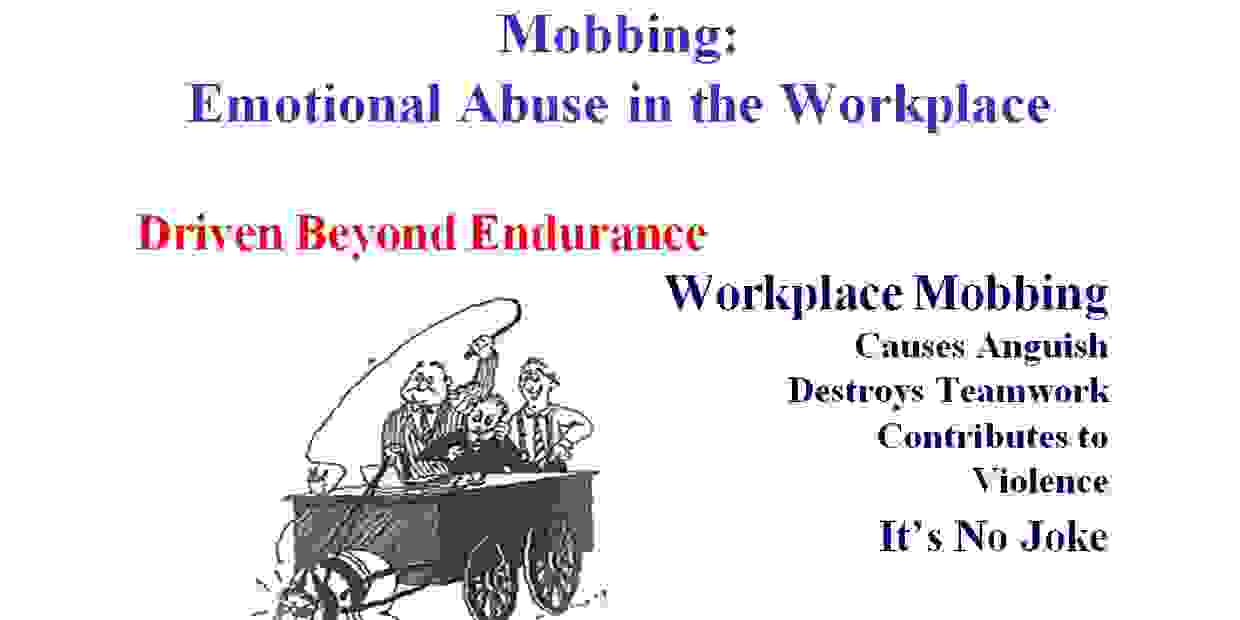Mobbing is Psychological, Emotional Abuse
Being subjected to Mobbing does not excuse someone of reprehensible conduct. It can, however, explain some of the dynamics that can lead up to acts of workplace violence. Some common characteristics of the perpetrators of mass killings are isolation, paranoia, feelings of persecution, preoccupation with survival. People who are being mobbed are often isolated first by others and then engage in self-isolation due to fear and uncertainty. They can develop feelings of paranoia and not know who can be trusted. Personality changes may occur. They often suffer from acute anxiety and/or post traumatic stress disorder just as those who have witnessed disasters, have been mugged, raped, or gone through war may experience. Knowledge of the Mobbing process, its impact on the individual and consequences to others help with prevention.
Mobbing and Bullying: Consultation, Speaking engagements
There are some who believe that this is just business. There are others who are unable to compartmentalize their actions toward others in such a way. Where are the lines in your organization? At what point will the cost become too high?
Conference Presentations
Seminars
Teleconferences and Webinars
Assembly Programs
Guest Faculty
Television and Radio Guest Expert
Consultation: On Site or On Call
Human Relations
High Turnover
Communication Issues
Low Morale
20 years experience working with
Federal, City, and County
Government Agencies
Health Care Organizations
Human Services Agencies
K-12 School Districts
Colleges and Universities
Mobbing Programs

Mobbing and Risk Management
Mobbing is group bullying. The term may be new to you but you will quickly recognize the behavior. Mobbing is a syndrome with a specific pattern. It is a ganging up by one or more individuals to force someone out of the workplace through rumor, innuendo, isolation, intimidation, discrediting, humiliation, and wrongly portrays the targeted person as being at fault. This status-blind form of harassment puts everyone at risk.

Mobbing and Discrimination Side Stepping the Law?
Regardless of the progress made through legislation over the years, discrimination and bigotry still exist and utilize more subtle tactics to exclude perceived undesirables from groups and organizations of all kinds. Although mobbing is usually described as a status-blind form of harassment it also can be used by some to mask discrimination directed at individuals associated with those groups protected by law.
School Mobbing
"While others hack away at the branches, only one will get to the root." This program is not anti-bullying but pro dignity and respect.
Mobbing is terrorism. The book deals with the issue from the perspective of all parties concerned -- the victim, the parents, the school staff, and even the perpetrator -- and it explains what each must do to resolve the situation.
Workplace Mobbing/Bullying
What's the difference between schoolyard bullies and workplace bullies? They're taller. Author Gail Pursell Elliott explains how this happens and offers suggestions to employees and employers.
School Mobbing/Bullying
Bullying and violence are outcomes. Mobbing is the process that gets you there. Proactive rather than reactive programs can create an environment where dignity and respect for everyone is the expectation.
5 Phases of the Mobbing Process
MOBBING IS...EMOTIONAL ABUSE in the workplace. "Ganging up" by co-workers, subordinates or superiors, to force someone out of the workplace through rumor, innuendo, intimidation, humiliation, discrediting, and isolation. Malicious, nonsexual, nonracial, general harassment. Other expressions for MOBBING are: Bullying, psychological terror or aggression, hostile behaviors at work, workplace trauma, incivility or emotional violence. MOBBING is a workplace safety and health issue.
Contact
Schedule a program or consultation.
Innovations "Training With a Can-Do Attitude"
Copyright © 2018 Innovations "Training With a Can-Do Attitude" - All Rights Reserved.
Powered by GoDaddy